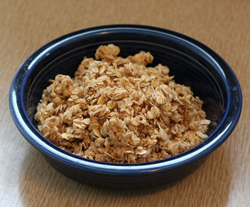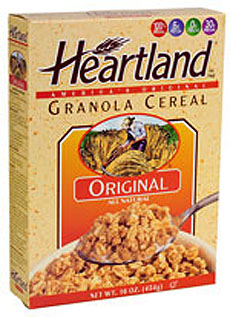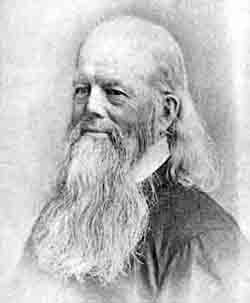

Invented in the 1800s, granola didn't go mainstream until over a century later. Photo by Andreas Virviescas | SXC.
|
KAREN HOCHMAN is Editorial Director of THE NIBBLE.
|
|
July 2009
Updated November 2012 |
 |
The History Of Granola
Page 2: The History Of Granola (Continued)
This is Page 2 of a three-page article, beginning with the history of granola. Click on the black links below to visit other pages.
The History Of Granola (Continued)
Trademark Lawsuit & The Debut Of “Granola”
When you think of Frosted Flakes and Cocoa Krispies, that’s not exactly what Dr. John Harvey Kellogg had in mind. Kellogg was one of America’s first health gurus, a Seventh-Day Adventist and superintendent of the Battle Creek Sanitarium in Michigan. The founder of the Seventh-Day adventists, Ellen G. White, who had sponsored Kellogg’s medical school education, had been a patient at Our Home On The Hill, and had experienced Granula. In what was not a coincidence, like James Caleb Jackson, Kellogg developed a breakfast cereal that he named Granula. Imitation is the sincerest form of flattery—except when you’re infringing on someone else’s trademark.
In 1881 (some sources say 1877), Dr. Kellogg took Jackson’s cereal invention and name, and started to produce his own Granula, although he modified the ingredients, substituting oats for graham flour clusters. He used a rolling process to flake the grain, making it more chewable. When Jackson sued him, Kellogg renamed his product Granola (and then went on to purloin Shredded Wheat, from a Denver man who invented and named the square wheat biscuits). |
|

Photo of modern granola © David Corby | Wikimedia. |
The names “Granula” (trademarked by Jackson) and “Granola” (trademarked by Kellogg) were trademarked for foods consisting of “natural herb products crumbled and then baked until crispy.” As Jackson had discovered earlier, there were big bucks to be made in cold breakfast cereal. Within a decade, Kellogg was selling two tons of it a week. With the success of Kellogg cereals, many new manufacturers appeared to cash in on the boom, including C.W. Post, who also set up production in Battle Creek.
The Invention Of The Great Boxed Cereal Brands
Dr. John Kellogg’s focus was on health and medicine—and inventing. He invented the first flaked breakfast cereal, made from wheat, in 1889, and a few years later invented flaked corn, better known as Corn Flakes, which really took off and made Battle Creek the world capital of breakfast cereal. In 1901, he created the Sanitarium Food Company as a subsidiary of the Battle Creek Sanitarium; in 1908 it became the Kellogg Food Company. His brother, William Kellogg, was the business head but the two brothers did not get along. In 1920 the brothers formally parted ways; the rights to manufacture cereal and the commercial use of the Kellogg name went to William, who established the W.K. Kellogg Company. Granola (and Granula) went out of fashion in favor of better-tasting cereals. “Kellogg’s Of Battle Creek” went on to produce Bran Flakes (1915), All Bran (1916), Rice Krispies (1927) and Raisin Bran* (1942). It was only after the death of William Kellogg in 1951 that the onslaught of sugared cereals targeted to kids began—Corn Pops, Frosted Flakes, Honey Smacks and Cocoa Krispies—not quite offset by the high protein Special K.
Granola was long off the manu by then, having been replaced by more palatable breakfast cereals. It remained a product known to a limited circle of “health food faddists” and Seventh Day Adventists until the hippie-spawned health food movement of the 1960s. Granula was long gone: Lacking a relative with business savvy, when the Jackson Sanitarium closed (see below), so did Granula production.
But hippies revived the rolled oats-based granola cereal and name, added dried fruits and nuts, and began to get visibility for the product (which in some circles earned jeers of derision for the “granola heads,” as the benefits of “healthy eating” were not widely recognized at the time.
*Skinner’s Raisin Bran was the first brand on the market, introduced in the U.S. in 1926 by U.S. Mills.
The Revival Of Modern Granola
Granola went mainstream in 1972, when the first major commercial granola,  Heartland Natural Cereal, was introduced by Pet Incorporated. In rapid succession, Quaker introduced Quaker 100% Natural Granola; Kellogg’s introduced Country Morning granola cereal and General Mills introduced Nature Valley granola. The granola wars of the 20th century were on. Heartland Natural Cereal, was introduced by Pet Incorporated. In rapid succession, Quaker introduced Quaker 100% Natural Granola; Kellogg’s introduced Country Morning granola cereal and General Mills introduced Nature Valley granola. The granola wars of the 20th century were on.
However, some of these “new” granolas— packed with raisins and other dried fruits, almonds and other nuts, sugar and other sweeteners—were as calorie rich (and sugar-rich) as some candy. Everyone was enjoying the delicious flavor so much (from the nuts, fruits and sweeteners), though, that nobody noticed until nutrition labeling arrived (under the provisions of the 1990 Nutrition Labeling and Education Act). After manufacturers were required to use a detailed food label on packages (beginning May 8, 1994), people who cared to read them learned that quite a few mass-marketed granolas were not exactly the health food that Drs. Jackson and Kellogg intended.
Now, there is a return to artisan-made, preservative-free granolas, sweetened with lower glycemic maple syrup or honey. Granola Girl is all of that, and more.
The End Of Dr. Jackson’s Spa
Whatever happened to Dr. Jackson and his thriving enterprise? After the Civil War, wealthy clients came to Our Home On The Hillside to bathe in and drink the mineral waters to relieve their ailments. Clara Barton, who returned to the U.S. in 1876, physically exhausted from years of non-stop travel and work as a nurse and humanitarian in the Civil War and the Franco-Prussian War, arrived to recuperate. (She founded the American Red Cross on May 21, 1881 in Dansville; national headquarters were later established in Pittsburgh.)
As previously noted, Ellen G. White, who founded the Seventh-Day Adventist religion, was also a patient. Our Home on the Hillside was a popular stop on the lecture circuit: Susan B. Anthony, Frederick Douglass, Elizabeth Cady Stanton and Horace Greeley all spoke there.
In the late 1870s, James Caleb Jackson turned the institution over to his younger son and daughter-in-law, both physicians, Drs. James H. and Kate J. Jackson. In June 1882, a fire completely destroyed the main building; but by October 1883, the Jacksons opened a new, larger, fireproof brick facility, and called it Jackson Sanatorium. It remained open until 1914. After World War I it was purchased and run as a resort hotel. The building is now boarded up in disrepair. However, according to the website Institutional Green, in January 2008, the Sanitarium was awarded $2.5 million from the State of New York for restoration. |
|

Photo of Dr. James Caleb Jackson courtesy of CrookedLakeReview.com. |
Continue To Page 3: Granola Girl Flavors
Go To The Article Index Above
Sources:
- Agilewriter.com/Biography/Kellogg.htm
- Crooked Lake Review.com: Read detailed bios and photos of Dr. Jackson
and his family
- Dailyapple.blogspot.com/2007/01/apple-214-milk-on-cereal.html
- Encyclopedia.com/doc/1G2-3436200163.html
- InstitutionalGreen.org
- Kellogghistory.com/history.html
- Postcereals.com/gn/
- Wikipedia

|




 Heartland Natural Cereal, was introduced by Pet Incorporated. In rapid succession, Quaker introduced Quaker 100% Natural Granola; Kellogg’s introduced Country Morning granola cereal and General Mills introduced Nature Valley granola. The granola wars of the 20th century were on.
Heartland Natural Cereal, was introduced by Pet Incorporated. In rapid succession, Quaker introduced Quaker 100% Natural Granola; Kellogg’s introduced Country Morning granola cereal and General Mills introduced Nature Valley granola. The granola wars of the 20th century were on. 